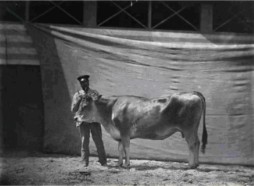The Irish Parthenaise Cattle Breed Society
Main menu:
- Home Page
- The Breed
- Breeders
- Sales, Shows and Events
- Sire Directory
- AI Sires
- Gallery
- Cross-Breeding
- Member's Herds
- Alamira Parthenaise Herd
- Ailsbury Farm
- Ban Na Buile Parthenaise
- Blackwater Parthenaise
- Boley House Parthenaise
- Culleens Farm Parthenaise Herd
- Cloonagh East Herd
- Keelties Parthenaise Herd
- Kileenbrack Parthenaise Herd
- Kilmannon Parthenaise Herd
- Killowen Parthenaise Herd
- Kyle Parthenaise Herd
- Lisnagranchy Parthenaise Herd
- Longford Parthenaise Herd
- Meadowridge Herd
- McGowan Parthenaise
- Na Fianna Parthenaise Herd
- Northview Parthenaise
- Slieve Bloom Parthenaise
- Tinnashinna Parthenaise
- Testimonials
- Contact Us
- Links
- Animals for Sale
- More Info
- ICBF Herdbook on line
The Breed
Origins of the breed
Like many of the continental breeds the Parthenaise breed has its origins in France. They have evolved from a group of closely related local strains kept in western France. The breed is named after the town of Parthenay. After winning a first prize at the national cattle show of Paris in 1856 (see black&white picture below) the parthenaise increased in popularity. A herdbook was established in 1893 making it one of the oldest beef breeds in France. Around the turn of the last century numbers had grown to about 1 million head of parthenaise. Originally a multi purpose breed with butter the most important dairy product and with the introduction of the Friesian, Normande and Charolais breeds the numbers had fallen to about 415,000 head by 1940. After the 1950s the breed was transformed into predominately a beef breed. By 1988 the numbers had decreased to 15,000 females, 2,000 of which were herdbook recorded along with 300 bulls.
Characteristics of the breed
The Parthenaise breed is an attractive breed, (especially the females) which are wheat to light brownish in colour with greyish/ blond around the eyes and muzzle. Both male and female have pronounced black pigmentation noticeable around the eyes. Muzzle and the hooves are also black. Cows weigh 750 to 1000kg. The bulls which weigh up to 1300kg are noticeably blacker in colour especially round the neck and shoulder. Parthenaise animals have good frame and fine bone with exceptional muscle development and have great mobility and thriftiness.

Nadar Jeune (Adrien Tournachon): Vache Parthenaise, agée de 5 ans. 1856, an original lithographed mount., First prize winner in her category at the Exposition Agricole de 1856.
Qualities
Parthenaise cattle may now no longer be primarily used for milk production but their strong maternal qualities and ancestral background of rich milk ensure that the calves grow well. Renowned for their high fertility, they calve regularly and easily, with little or none of the double muscle shown at birth, the calves being born small (females 43kg-males 46kg) and very lively at birth, with the result that productivity is high, although like with all breeds some of the larger skeletal bulls should be used with caution. French calving survey reveal 62% easy, 29% easy with assistance, 5% difficult and 4% caesarian. The Parthenaise thrives on all types of terrain and coming from western France where climatic conditions are not too dissimilar to Irish conditions they are shown to cope very well and have very good disease resistance.
Parthenaise in Ireland
Parthenaise were first imported into Ireland around 1997. Since then the breed has enjoyed a relatively slow but steady increase in popularity bearing in mind that they have to compete with many other continental breeds well established in this country since the 70s and 80s, many of which only had to compete with the traditional Irish and English breeds, when, they first arrived into Ireland. There are approx forty five pedigree breeders in Ireland and many Parthenaise bulls on duty round the country. It was not until the figures started being returned from the progeny of UNIVERSAL UNI, ( the first Parthenaise bull into an Irish AI station) that people took note. UNI's Suckler Beef Value of €269 being returned are matching that, and surpassing most of the other continental breeds. From the latest batch of bulls to exit Tully research station a new Parthenaise bull Slieve Bloom Dominator has emerged as the top performing bull from ten different beef breeds. Other Irish bred bulls in Irish AI stations include Kyle Chap which is a new bull in Dovea and is a half brother to UNI, Lisnagranchy Carlo who was reserve champion to UNI at Beef Expo '08, Cambridge out the Supreme Champion cow Ulia at Beef Expo '08. Many other top French bulls are available through the Society.
Breed improvements
Since the 1980s a breeding improvement programme has been organized by UPRA Parthenaise.
This entails:
" Scoring controls on 13.000 cows.
" Registration and qualification of animals.
" Evaluation in test station "Melle" of 100 young bulls per year for natural service.
" Top five bulls from Melle for AI after test period.
Production goals of the breed
To get male and female 400kg carcass weight, E,U,S graded European classification system without breeding difficulty.